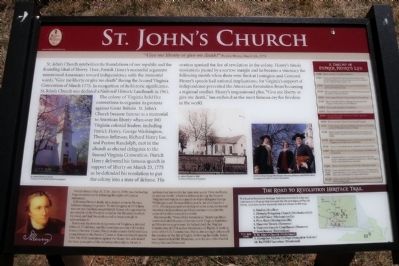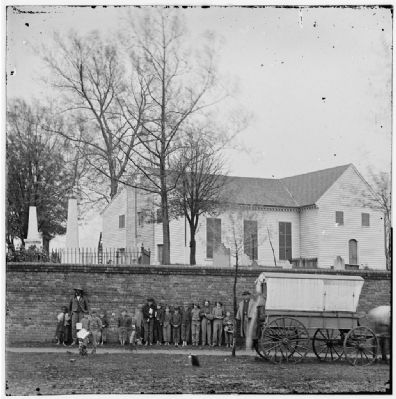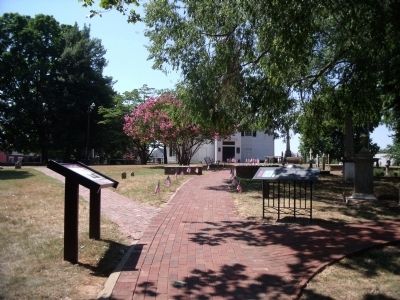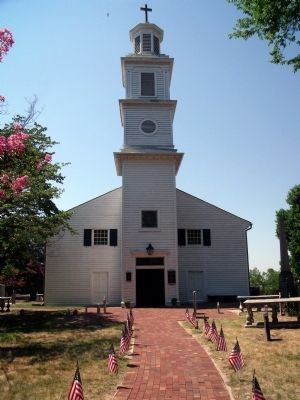Church Hill in Richmond, Virginia — The American South (Mid-Atlantic)
St. Johnís Church
ďGive me liberty or give me death!Ē
ó Patrick Henry, March 23, 1775 ó
The colony of Virginia held five conventions to organize its protests against Great Britain. St. Johnís Church became famous as a memorial to American liberty when over 100 Virginia colonial leaders, including Patrick Henry, George Washington, Thomas Jefferson, Richard Henry Lee, and Peyton Randolph, met in the church as elected delegates to the Second Virginia Convention. Patrick Henry delivered his famous speech in support of liberty on March 23, 1775 as he defended his resolution to put the colony into a state of defense. His oration sparked the fire of revolution in the colony. Henryís timely resolutions passed by a narrow margin and he became a visionary the following month when shots were fired at Lexington and Concord. Henryís speech had national implications, for Virginiaís support of independence prevented the American Revolution from becoming a regional conflict. Henryís impassioned plea, “Give me liberty or give me death,” has endured as the most famous cry for freedom in the world.
(sidebar)
Patrick Henry (May 29, 1736 – June 6, 1799) was the leading Virginia statesman in defending the rights of Colonial America.
Following Henry's death, John Adams wrote to Thomas Jefferson singing his praises: “In the Congress of 1774 there was not one member, except Patrick Henry, who appeared to me sensible of the Precipice or rather the Pinnacle on which he stood, and had the candour and courage enough to acknowledge it.”
Henry was the first elected governor of Virginia, a devoted father of 17 children, and the most famous orator of his day. Born in Hanover County, Henry made a name for himself as a young lawyer in the Parsonsí Cause at Hanover Courthouse in 1763. His 1765 resolutions against the Stamp Act articulated the basic principles of the American Revolution. Henry is perhaps best known for his immortal words “Give me liberty or give me death,” which he delivered during the Second Virginia Convention in a speech to fellow delegates George Washington and Thomas Jefferson at St. Johnís Church in 1775. His impassioned words helped move colonists toward American independence and they continue to inspire the cause of freedom around the world.
Known as the “Voice of the Revolution,”
Henryís political career included 26 years of service in the Virginia legislature and five terms as governor. He helped draft the Virginia Constitution of 1776 and its Declaration of Rights. A leading critic of the U.S. Constitution, Henry also strongly influenced the creation of the Bill of Rights. Following his death, Henry was buried at Red Hill Plantation, now the site of the Patrick Henry National Memorial.
Erected 2010 by The Road to Revolution Heritage Trail. (Marker Number 8.)
Topics and series. This historical marker is listed in these topic lists: Churches & Religion • Colonial Era • Patriots & Patriotism • War, US Revolutionary. In addition, it is included in the Former U.S. Presidents: #02 John Adams, and the Former U.S. Presidents: #03 Thomas Jefferson series lists. A significant historical year for this entry is 1775.
Location. 37° 31.913′ N, 77° 25.174′ W. Marker is in Richmond, Virginia. It is in Church Hill. Marker can be reached from the intersection of East Broad Street and North 24th Street. Touch for map. Marker is at or near this postal address: 2401 East Broad Street, Richmond VA 23223, United States of America. Touch for directions.
Other nearby markers. At least 8 other markers are within walking distance of this marker. Welcome to Historic St. Johnís Church (a few steps from this marker); St. John's Episcopal Church (a few steps from this marker); Saint Johnís Episcopal Church (a few steps from this marker); Major William Mayo (a few steps from this marker); British Invasion of Richmond, January 1781 (within shouting distance of this marker); Patrick Henry Memorial Park (within shouting distance of this marker); George Wythe (within shouting distance of this marker); World War II Memorial (about 300 feet away, measured in a direct line). Touch for a list and map of all markers in Richmond.
More about this marker. On the left is a photo of "St. Johnís Church in Spring Courtesy of St. Johnís Church Foundation". In the center is a period photo of "St. Johnís Church in 1865 Courtesy of Library of Congress". On the right is a photo with the caption,"Actors portray George Washington, Thomas Jefferson, and Patrick Henry Courtesy of St. Johnís Church Foundation".
Also see . . . St. Johnís Church. (Submitted on July 5, 2010.)
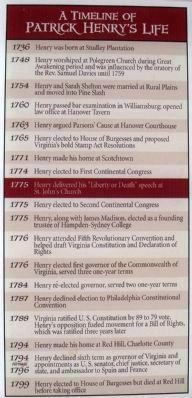
5. A Timeline of Patrick Henry's Life
1736 Henry was born at Studley Plantation
1748 Henry worshiped at Polegreen Church during Great Awakening period and was influenced by the oratory of the Rev. Samuel Davies until 1759
1754 Henry and Sarah Shelton were married at Rural Plains and moved into Pine Slash
1760 Henry passed bar examination in Williamsburg; opened law office at Hanover Tavern
1763 Henry argued Parsonsí Cause at Hanover Courthouse
1765 Henry elected to House of Burgesses and proposed Virginiaís bold Stamp Act Resolutions
1771 Henry made his home at Scotchtown
1774 Henry elected to First Continental Congress
1775 Henry delivered his “Liberty or Death” speech at St. Johns Church
1775 Henry elected to Second Continental Congress
1775 Henry, along with James Madison, elected as a founding trustee of Hampden-Sydney College
1776 Henry attended Fifth Revolutionary Convention and helped draft Virginia Constitution and Declaration of Rights
1776 Henry elected first governor of the Commonwealth of Virginia, served three one-year terms
1784 Henry re-elected governor, served two one-year terms
1787 Henry declined election to Philadelphia Constitutional Convention
1788 Virginia ratified U.S. Constitution by 89 to 79 vote, Henryís opposition fueled movement for a Bill of Rights, which was ratified three years later
1794 Henry made his home at Red Hill, Charlotte County
1794 through 1796 Henry declined sixth term as governor of Virginia and appointments as U.S. senator, chief justice, secretary of state, and ambassador to Spain and France
1799 Henry elected to House of Burgesses but died at Red Hill before taking office
1748 Henry worshiped at Polegreen Church during Great Awakening period and was influenced by the oratory of the Rev. Samuel Davies until 1759
1754 Henry and Sarah Shelton were married at Rural Plains and moved into Pine Slash
1760 Henry passed bar examination in Williamsburg; opened law office at Hanover Tavern
1763 Henry argued Parsonsí Cause at Hanover Courthouse
1765 Henry elected to House of Burgesses and proposed Virginiaís bold Stamp Act Resolutions
1771 Henry made his home at Scotchtown
1774 Henry elected to First Continental Congress
1775 Henry delivered his “Liberty or Death” speech at St. Johns Church
1775 Henry elected to Second Continental Congress
1775 Henry, along with James Madison, elected as a founding trustee of Hampden-Sydney College
1776 Henry attended Fifth Revolutionary Convention and helped draft Virginia Constitution and Declaration of Rights
1776 Henry elected first governor of the Commonwealth of Virginia, served three one-year terms
1784 Henry re-elected governor, served two one-year terms
1787 Henry declined election to Philadelphia Constitutional Convention
1788 Virginia ratified U.S. Constitution by 89 to 79 vote, Henryís opposition fueled movement for a Bill of Rights, which was ratified three years later
1794 Henry made his home at Red Hill, Charlotte County
1794 through 1796 Henry declined sixth term as governor of Virginia and appointments as U.S. senator, chief justice, secretary of state, and ambassador to Spain and France
1799 Henry elected to House of Burgesses but died at Red Hill before taking office
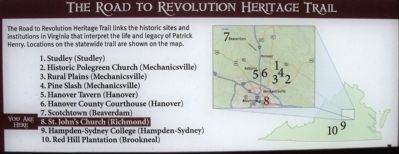
July 5, 2010
6. The Road to Revolution Heritage Trail
The Road to Revolution Heritage Trail links the historic sites and institutions in Virginia that interpret the life and legacy of Patrick Henry. Locations on the statewide trail are shown on the map.
1. Studley (Studley)
2. Historic Polegreen Church (Mechanicsville)
3. Rural Plains (Mechanicsville)
4. Pine Slash (Mechanicsville)
5. Hanover Tavern (Hanover)
6. Hanover County Courthouse (Hanover)
7. Scotchtown (Beaverdam)
8. St. Johnís Church (Richmond)
9. Hampden-Sydney College (Hampden-Sydney)
10. Red Hill Plantation (Brookneal)
1. Studley (Studley)
2. Historic Polegreen Church (Mechanicsville)
3. Rural Plains (Mechanicsville)
4. Pine Slash (Mechanicsville)
5. Hanover Tavern (Hanover)
6. Hanover County Courthouse (Hanover)
7. Scotchtown (Beaverdam)
8. St. Johnís Church (Richmond)
9. Hampden-Sydney College (Hampden-Sydney)
10. Red Hill Plantation (Brookneal)
Credits. This page was last revised on February 1, 2023. It was originally submitted on July 5, 2010, by Bernard Fisher of Richmond, Virginia. This page has been viewed 2,096 times since then and 67 times this year. It was the Marker of the Week March 20, 2011. Photos: 1, 2, 3, 4, 5, 6. submitted on July 5, 2010, by Bernard Fisher of Richmond, Virginia.
